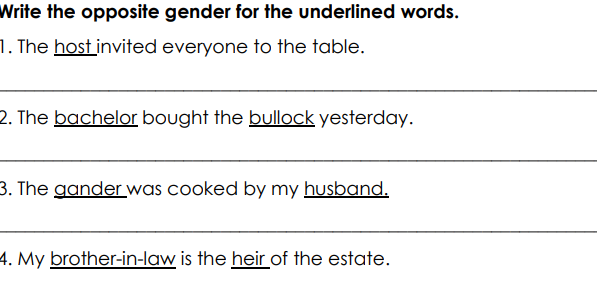Section A - Formation of Adjectives
Fill in the blanks with suitable adjectives
1 .The ship was badly__________ .(damage)
2. It is___________________ to carry water in a basket. (point)
3. He is so absent ________________.(mind)
4. I was extremely________________ on the day of the exam. (nerve
5. She isn’t_________ enough for this work. (create)
6. The problem is that he sometimes can be very____________. (annoy)
7. Late applications are not_______________. (accept)
8. Why don ‘t you try to be more__________________? (friend)
Section B - Conjunctions
Choose the correct conjunction.
1. I did my best to pass my English exam (yet/so) I failed.
2. I will get my car serviced (and/for) there is something wrong with the brakes.
3. The suspect went to the airport (and/yet) tried to use a license that had his brother's
identification on it (or/but) he got caught.
4. Nobody expected Sam to get the job (nor/so) did I.
5. We can go to a Chinese restaurant (or/and) a Mexican, I don’t really mind.
6. It was raining heavily (and / so) we decided to stay at home.
7. Everybody was eager to participate in the charity walk (or / but) the manager.
Section C - Active & Passive Voice
Rewrite in the passive voice
She cleans the apartment every week.
____________________________________________________
We have taken many tests this term.
____________________________________________________Many friends called me on my birthday.
____________________________________________________
Someone will call you this evening.
____________________________________________________
The secretary is preparing the final exam.
____________________________________________________The mailman might deliver the package tomorrow.
____________________________________________________
Section D - Subject/Verb Agreement
1. A hiker (walk, walks) along trails that are not very steep.
2. Rock climbers (choose, chooses) steeper slopes.
3. Smooth rocks (require, requires) special climbing techniques.
4. A rock climber (need, needs) special equipment to ascend a mountain.
5. The players and coaches (meet, meets) on the field.
6. The team (drink, drinks) water during and after practice.
Section E - Homophones
1. (They’re, There, Their) will be an election for class officers tomorrow.
2. If you want to run for office, submit (your, you’re) name to Mr. Hoang.
3. (Who’s, Whose) going to run for class president?
4. Victor and Leah are (too, two, to) good candidates for treasurer.
5. Students who run for election will have (they’re, their, there) name on the ballot.
6. (It’s, Its) going to be an interesting race!
Section F - Comparison of Adjectives
Please sit down. You will feel………………………………. (Comfortable) then.
Lead is …………. (Heavy) than gold.
The view of the hills from the balcony of his apartment is……………….(lovely) than it is from mine.
I found myself in the ……… (Funny) of situations on my birthday.
You are………… (Thin) than most of our friends.
The cheetah runs …….than any other animal on earth. (fast)
Spelling mistakes in English are………… (Frequent) in words with silent letters
Electricity
Electricity is a secondary energy source. Electricity is the flow of electrical power or charge. Electricity is both a basic part of nature and one of the most widely used forms of energy. The electricity that we use is a secondary energy source because it is produced by converting primary sources of energy such as coal, natural gas, nuclear energy, solar energy, and wind energy, into electrical power. Electricity is also referred to as an energy carrier, which means it can be converted to other forms of energy such as mechanical energy or heat. Primary energy sources are renewable or nonrenewable energy, but the electricity we use is neither renewable nor nonrenewable.
Despite its great importance in daily life, few people probably stop to think about what life would be like without electricity. Like air and water, people tend to take electricity for granted. However, people use electricity to do many jobs every day—from lighting, heating, and cooling homes to powering televisions and computers.
Before electricity became widely available, about 100 years ago, candles, whale oil lamps, and kerosene lamps provided light; iceboxes kept food cold; and wood-burning or coal-burning stoves provided heat.
Scientists and inventors have worked to decipher the principles of electricity since the 1600s. Benjamin Franklin, Thomas Edison, and Nikola Tesla made notable contributions to our understanding and use of electricity. Benjamin Franklin demonstrated that lightning is electricity. Thomas Edison invented the first long-lasting incandescent light bulb.
Before 1879, direct current (DC) electricity was used in arc lights for outdoor lighting. In the late 1800s, Nikola Tesla pioneered the generation, transmission, and use of alternating current (AC) electricity, which reduced the cost of transmitting electricity over long distances. Tesla's inventions brought electricity into homes to power indoor lighting and into factories to power industrial machines.
Answer the following questions
1. What is electricity?
2. Why is the electricity that we use, considered a secondary source of energy?
3. What is meant by the term energy carrier?
4. List TWO jobs that people use electricity to do.
5. From the passage, identify THREE things that were used to provide energy before the
invention of electricity.
6. Name THREE persons who made a significant contribution to our understanding of
electricity.
7. What does the abbreviation DC mean?
A box contains 37 chocolates. How many chocolates are there in 23 of these boxes?
2-5.
6. Sally bought two Lego sets. One cost $36.97 and the other cost $47.76.
How much did she spend in total on these two Lego sets?
7. A model of calculator has 49 buttons. The manufacturer of the calculators wants
to produce 3480 calculators. How many buttons will be needed?
Use BODMAS to calculate:
8. 6 + 4 ÷ 2
9. 7-3 x 2
10. Calculate half of one sixth.
11. An iPhone used to cost $500. The price has increased by 22%. How much does it cost now?
12. Tickets to a World Cup Cricket match cost $60.00 for each adult and half price for each child.
How much did a family of 2 adults and 1 child pay for their tickets?
13. The area of a square plot of land is144m². What is the length of one side?
14. Jack went to sleep at 8:05 pm. His sister went to sleep 45 minutes before him. At what time
did Jack’s sister go to sleep?
15.
16. A box of sweets was shared among 8 friends. Each person received 12 sweets. If there were
7 extra sweets, how many sweets were in the box?
17. 4.3 + 8.4 + 9.5 =
18. If 3.15 ´ 10 = 31.5, then 3.15 ´ 100 =
19.
20. What is the L.C.M. of 4 and 6?
21.
22.
23.
24. 25% written as a fraction is _______
25.
26. A farmer divides 1500 mangoes between two vendors in the ratio 2 : 3. How many mangoes does each vendor get?
27.
28. What needs to be added to 5.4 to make 9.3?
29. 50% of a number is 200. What is 1% of the same number?
30. Share $650 between 2 friends so that 1 friend gets $80 more than the other.
1. What type of dog is Bella?
2. The family may have to "surrender" Bella if her behaviour does not change. What do you think this means?
3. What do you understand Cesar's job to be?
4. Why did Cesar first come to work with Bella?
5. Why was the husky brought to Bella's house?
6. Why does Bella's owner have her wear a weighted vest?
Activity 2: Word Formation
HOMEWORK
Use the link below to complete the five word problems on the second page.
Wednesday, March 10, 2022
English Revision
You may print if you choose.
Complete all questions except 8-13
https://www.svgcdu.org/_files/ugd/fffeb7_3e16e47336e248c583aada76b1ea1f5d.pdf
TOPICS
1. On your way to school one morning you see a huge truck speeding down the road. Suddenly, the back door of the truck opens and a large, mysterious box falls off the back
of the truck. It sits there in the road. Tell the story of what happens to this mysterious box. Give your story a name.
2. Describe the most exciting adventure you have ever had.
3. Write a letter to your parents to persuade or convince them to leave the city or town and move to a neighbourhood in the country to live. Give three reasons to support your
suggestion.
4. State three rules that every school should have. Write a composition explaining why every school should have these rules.
Solve these. Tip: Each correct response begins with the "bl‟ 1. You see this when your skin gets a cut ___________ 2. Accuse someone ________________ 3. Sharp object that cuts ___________ 4. Colour of the sky ___________ 5. A type of shirt ________
Solve these. Tip: Each correct response begins with the "gl‟
1. A ________________________ is a model of the Earth. 2. I will put some ________________________ on the papers to hold them together. 3. My new ________________________ help me see better
Fill each gap with a compound word formed from the word in the brackets. Remember each word needs a hyphen. 1. Someone around forty to fifty years old is said to be _______________________. (middle)
2. If you have ____________________, you will not lose your temper easily. (control)
3. I can‘t write well with my left hand; I am ____________________. (right)
Mathematics Revision
1.
2.
4. The value of 7 in 3572 is _______
5. What amount must be added to 0.06 to make 1?
6. Ripe bananas are sold at four different rates. Which rate shown below is the cheapest?
A 3 for 12¢
B 5 for 80¢
C 8 for 40¢
D 10 for 30¢
7. There are 60 chairs in the lunchroom. The ratio of chairs to tables is 4:1. How many tables are there?
8. The length of each side of this shape is 4 cm. What is the perimeter of the shape?



















Comments
Post a Comment